It's been almost two weeks since I last posted on here. Although I haven't been traveling anywhere, I've been incredibly busy with work. Since my last post, my father had actually come back to Belgium on a business trip. After work all of last week, we went out to some restaurants and as a result, I didn't get back to my flat until pretty late at night. At that point, I didn't have time to update my blog.
I'm still in Belgium wrapping things up. Tomorrow is my last day here at IMEC. I actually need to start making a presentation for tomorrow, so I'll end this post here. To whoever reads this blog, no worries, I'm still alive!
This blog is dedicated to my adventures and experiences traveling around Europe and performing research with the Interuniversity Microelectronics Center (IMEC) through JHU's Institute for NanoBiotechnology's (INBT) IRES program (http://inbt.jhu.edu/)
Tuesday, August 25, 2009
Thursday, August 13, 2009
Post-London
After visiting London, I spent the next two weekends just relaxing around Belgium and visiting some nearby cities. Both weekends I ended up going back to IMEC to work on a couple things. Even though I'm over here in Belgium, I'm still able to work on some things for my research back at Hopkins like editing figures and drafts for papers we're in the process of submitting and publishing.
My time here at IMEC is winding down far too quickly. Even with an entire summer over here, it's not enough time complete a project. No matter what type of facilities you have, finishing a project in 3 months is incredibly difficult. Originally, INBT's IRES program was slated to last between 8-10 weeks for undergrads. I can't imagine being limited to such a short time span. It took me at least 3-4 weeks just to get situated and trained on the basic instruments. I waited 2 weeks just to get trained for general clean room use.
I think I forgot to mention the differences between university research and industrial research. Transitioning into university research is significantly more fast paced than in industry. At the university setting, your research groups are generally small and it's much more personal. You can use almost any instrument as long as you receive training. Training itself is generally easy to obtain. Simply ask someone to show you how to use the instrument. At large companies, there's always paperwork involved and training sessions to be scheduled weeks in advance. This is all for liability purposes. If you make a mistake, there is a lot on the line for the company, including its reputation and your own personal safety. As a result, in order to limit liability, companies have formalities that must be followed to the dot.
My last internship at ExxonMobil was exactly the same. In order to use certain solvents, I had to file paperwork and then wait for it to be processed. Specifically, I wasn't allowed to use chloroform until I had the correct paperwork filed. It's an annoying inconvenience, but for large corporations it's a necessity. IMEC, however, isn't as strict as ExxonMobil. I've used HF without ever having to sign a document beforehand.
I've already mentioned before that technicians operate a lot of the instruments here, including thermal evaporators, select sputter systems, select plasma etchers, e-beams, and a large majority of the expensive instruments. Before being allowed to use some of the instruments, I had to verify my fabrication process with some of the technicians. I had to discuss with them the composition of my samples and why I needed to use certain instruments. It took me almost 3 weeks to get approval to use a plasma etcher. At one point, I almost wasn't allowed to use the etcher at all because the technician feared that my sample might ruin the instrument. After some convincing, I was luckily allowed access to the instrument. My point here is that in industry, your research goes by much slower than in a university setting. Sometimes I'll wait 3 days to run my samples through a single process. If I was back at Hopkins, I could have it done in less than half an hour.
The most noticeable difference between research at the university and in industry is the pace at which it progresses. Although it may not be desirable, you just have to acclimate to the change in pace.
My time here at IMEC is winding down far too quickly. Even with an entire summer over here, it's not enough time complete a project. No matter what type of facilities you have, finishing a project in 3 months is incredibly difficult. Originally, INBT's IRES program was slated to last between 8-10 weeks for undergrads. I can't imagine being limited to such a short time span. It took me at least 3-4 weeks just to get situated and trained on the basic instruments. I waited 2 weeks just to get trained for general clean room use.
I think I forgot to mention the differences between university research and industrial research. Transitioning into university research is significantly more fast paced than in industry. At the university setting, your research groups are generally small and it's much more personal. You can use almost any instrument as long as you receive training. Training itself is generally easy to obtain. Simply ask someone to show you how to use the instrument. At large companies, there's always paperwork involved and training sessions to be scheduled weeks in advance. This is all for liability purposes. If you make a mistake, there is a lot on the line for the company, including its reputation and your own personal safety. As a result, in order to limit liability, companies have formalities that must be followed to the dot.
My last internship at ExxonMobil was exactly the same. In order to use certain solvents, I had to file paperwork and then wait for it to be processed. Specifically, I wasn't allowed to use chloroform until I had the correct paperwork filed. It's an annoying inconvenience, but for large corporations it's a necessity. IMEC, however, isn't as strict as ExxonMobil. I've used HF without ever having to sign a document beforehand.
I've already mentioned before that technicians operate a lot of the instruments here, including thermal evaporators, select sputter systems, select plasma etchers, e-beams, and a large majority of the expensive instruments. Before being allowed to use some of the instruments, I had to verify my fabrication process with some of the technicians. I had to discuss with them the composition of my samples and why I needed to use certain instruments. It took me almost 3 weeks to get approval to use a plasma etcher. At one point, I almost wasn't allowed to use the etcher at all because the technician feared that my sample might ruin the instrument. After some convincing, I was luckily allowed access to the instrument. My point here is that in industry, your research goes by much slower than in a university setting. Sometimes I'll wait 3 days to run my samples through a single process. If I was back at Hopkins, I could have it done in less than half an hour.
The most noticeable difference between research at the university and in industry is the pace at which it progresses. Although it may not be desirable, you just have to acclimate to the change in pace.
Tuesday, August 11, 2009
London Part 3
I still have quite a bit to discuss about London. Picking up from where I left off, on my last day in London I first stopped by Westminster Abbey.


I was a little surprised about how pricey admission into the cathedral was. There were no student discounts, so the full fare was 15 British pounds (~$25). Although an audio listening device was provided at no additional cost, it was still rather expensive.
Inside the abbey is a coronation chair where all English and British monarchs sit when they're being crowned. It's been used at every coronation since 1308. I couldn't take pictures inside, so I won't be able to show images.
The Abbey is also the location of many burial sites. On the ground inside the Abbey, there are slabs the size of coffins that acknowledge the body of the person lying below. Several historical figures that are buried here include Charles Dickens, Jane Austin, Sir Isaac Newton, and Charles Darwin.
London's Tomb of the Unknown Solider is also located in Westminster Abbey.
After visiting the Abbey, I made my way to the British Museum.
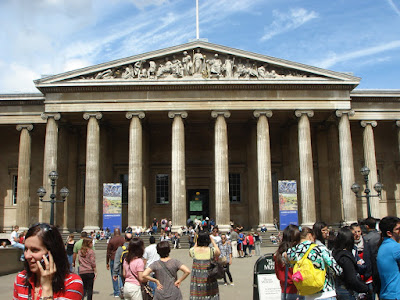
This museum is essentially a miniaturized version of the Louvre in Paris. It contains a hodgepodge of antiquities ranging from ancient Egypt, Greece, Asia, Africa, and the Americas. The most spectacular piece in their collection is the Rosetta Stone.

The crowd gathered around the Rosetta Stone reminded me of the crowd around the Mona Lisa in Paris. An arc of people surround the perimeter and all were trying to take snapshots. I think part of the reason for the large crowd stems from the fact that the Rosetta Stone is placed in the first room you run into after gaining admission into the museum. It is the museum's highlight, so I guess it makes sense for it to be at the forefront.
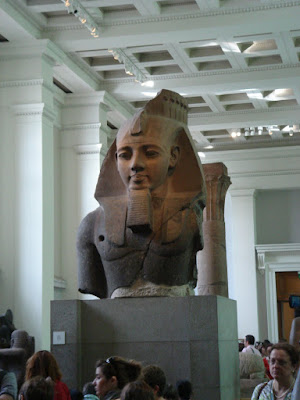
In the Egyptian exhibit there's a huge bust of Ramses II. There were also the obligatory mummies on display as well.

In the Greece exhibit, remnants of the Parthenon were on display.
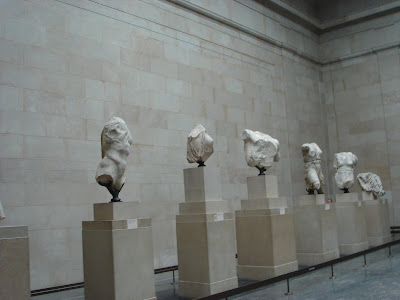
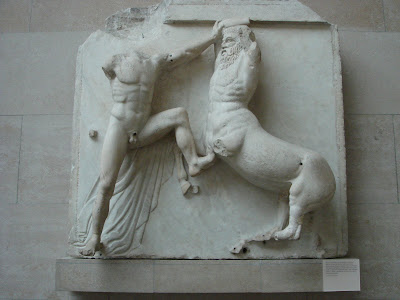
After wandering into the Asian antiquities section I found this little guy.

For some reason, this guy reminds me of the Power Rangers. I feel like this monkey just morphed into his combat costume or something. Either that or he's a well-fashioned zord (most likely belonging to the yellow ranger). However, I think the Sabre-Toothed Tiger is more intimidating than this little guy. Unibrows are not intimidating. Okay, enough of the Power Rangers flashback. Onwards we go.
After leaving the the Asian antiquities exhibit, I kind of got lost and I randomly starting walking around the museum. Somehow I ended up in an exhibit featuring the oldest known chess set. It was discovered in 1831 and is carved out of walrus teeth.

I also found this violin-like instrument on display.
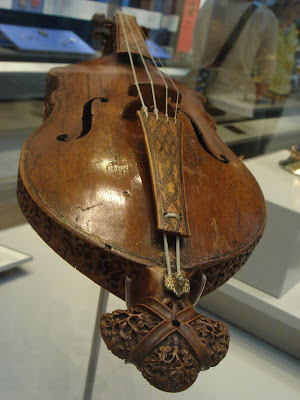
It supposedly dates back to 1300. The side view of this instrument I found to be much more interesting.
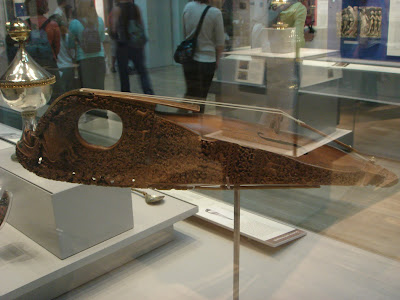
The British Museum had plenty more exhibits and antiquities, however, I'm only mentioning here the main highlights.
After walking around the museum for a couple hours, I decided to find somewhere to go for dinner. I stumbled into a restaurant called the Criterion. I found it from my guidebook, but it didn't mention that the place was classy. I came in horribly under dressed, wearing jeans and birkenstocks. They didn't refuse at the door though, so I just sat down and decided to have my dinner there.

For my appetizer, I got king scallops with shrimp.

Unfortunately, the scallops weren't very king size.
And for my main course I got ostrich fillets! It was the oddest thing that I saw on the menu, so I obviously just had to try it. Not even Asians eat ostrich, so I guess English cuisine is pretty daring, or probably just more sophisticated. Yeah, I'll go with more classy/sophisticated.

After I ordered the ostrich, the waitress asked me how I would like it cooked. Maybe I'm gullible, but I just glaringly stared at her, confused for a little bit, because I didn't know what my options were. Apparently it's just like ordering steak, so I ordered medium. The taste of the meat was a mix between lamb and beef. In addition, the color of the meat was very dark. By looking at it, I could barely tell it was medium. I was only able to notice after taking a bite and noticing the texture. Overall it was an interesting experience. I enjoyed the taste and if given the chance to order it again, I think I would.
Anyway, this dinner concluded my trip to London. Right after this I had to go back to the hostel to retrieve my things and then head back home to Leuven.
I thoroughly enjoyed my time in this magnificent city. Even after 4 days, I didn't get close to seeing as much as I had hoped. Perhaps there will be a next time...
I was a little surprised about how pricey admission into the cathedral was. There were no student discounts, so the full fare was 15 British pounds (~$25). Although an audio listening device was provided at no additional cost, it was still rather expensive.
Inside the abbey is a coronation chair where all English and British monarchs sit when they're being crowned. It's been used at every coronation since 1308. I couldn't take pictures inside, so I won't be able to show images.
The Abbey is also the location of many burial sites. On the ground inside the Abbey, there are slabs the size of coffins that acknowledge the body of the person lying below. Several historical figures that are buried here include Charles Dickens, Jane Austin, Sir Isaac Newton, and Charles Darwin.
London's Tomb of the Unknown Solider is also located in Westminster Abbey.
After visiting the Abbey, I made my way to the British Museum.
This museum is essentially a miniaturized version of the Louvre in Paris. It contains a hodgepodge of antiquities ranging from ancient Egypt, Greece, Asia, Africa, and the Americas. The most spectacular piece in their collection is the Rosetta Stone.
The crowd gathered around the Rosetta Stone reminded me of the crowd around the Mona Lisa in Paris. An arc of people surround the perimeter and all were trying to take snapshots. I think part of the reason for the large crowd stems from the fact that the Rosetta Stone is placed in the first room you run into after gaining admission into the museum. It is the museum's highlight, so I guess it makes sense for it to be at the forefront.
In the Egyptian exhibit there's a huge bust of Ramses II. There were also the obligatory mummies on display as well.
In the Greece exhibit, remnants of the Parthenon were on display.
After wandering into the Asian antiquities section I found this little guy.
For some reason, this guy reminds me of the Power Rangers. I feel like this monkey just morphed into his combat costume or something. Either that or he's a well-fashioned zord (most likely belonging to the yellow ranger). However, I think the Sabre-Toothed Tiger is more intimidating than this little guy. Unibrows are not intimidating. Okay, enough of the Power Rangers flashback. Onwards we go.
After leaving the the Asian antiquities exhibit, I kind of got lost and I randomly starting walking around the museum. Somehow I ended up in an exhibit featuring the oldest known chess set. It was discovered in 1831 and is carved out of walrus teeth.
I also found this violin-like instrument on display.
It supposedly dates back to 1300. The side view of this instrument I found to be much more interesting.
The British Museum had plenty more exhibits and antiquities, however, I'm only mentioning here the main highlights.
After walking around the museum for a couple hours, I decided to find somewhere to go for dinner. I stumbled into a restaurant called the Criterion. I found it from my guidebook, but it didn't mention that the place was classy. I came in horribly under dressed, wearing jeans and birkenstocks. They didn't refuse at the door though, so I just sat down and decided to have my dinner there.
For my appetizer, I got king scallops with shrimp.
Unfortunately, the scallops weren't very king size.
And for my main course I got ostrich fillets! It was the oddest thing that I saw on the menu, so I obviously just had to try it. Not even Asians eat ostrich, so I guess English cuisine is pretty daring, or probably just more sophisticated. Yeah, I'll go with more classy/sophisticated.
After I ordered the ostrich, the waitress asked me how I would like it cooked. Maybe I'm gullible, but I just glaringly stared at her, confused for a little bit, because I didn't know what my options were. Apparently it's just like ordering steak, so I ordered medium. The taste of the meat was a mix between lamb and beef. In addition, the color of the meat was very dark. By looking at it, I could barely tell it was medium. I was only able to notice after taking a bite and noticing the texture. Overall it was an interesting experience. I enjoyed the taste and if given the chance to order it again, I think I would.
Anyway, this dinner concluded my trip to London. Right after this I had to go back to the hostel to retrieve my things and then head back home to Leuven.
I thoroughly enjoyed my time in this magnificent city. Even after 4 days, I didn't get close to seeing as much as I had hoped. Perhaps there will be a next time...
Monday, August 10, 2009
IMEC Update 8/10/09
As my time here is winding down, I'm scrambling to get in as much work as I possibly can. From today, I have a little more than 2 weeks left here in Belgium. All good things must come to an end, there are no exceptions.
So what have I been up to at IMEC? Almost all the work that I do is inside the clean room. All day I go in and out, changing into the clean room suits probably more than 5 times a day. Every instrument involved in lithographic fabrication is inside one of the many sections of the clean room here, including thermal evaporators, sputter systems, ion-milling systems, electron beam evaporators, profilometers and ellipsometers, solvent/acid wet benches, plasma etchers, dicing tools, optical microscopes, spin-coaters, mask aligners (3 in a single room capable of handling 8" wafers. They have more than 3 mask aligners here. These 3 are just the ones that I have access to.) and numerous other instruments used for functions that I'm not aware of.
As I've mentioned months earlier, the most annoying part about research here at IMEC is still the fact that technicians operate most the instruments. Yes, I'm thankful that it's less work for me since I don't have to run the instrument, however, sometimes I'll wait a day or 2 for my sample to be processed. Although I have enough work to do to keep me busy in the mean time, sometimes the samples that I need processed are the ones that I desperately need the most. The worst offending instrument is the e-beam (electron beam instrument used for lithography).
There are multiple different forms of lithography. Two such types include photolithography and electron beam lithography. The advantage of e-beam lithography over photolithography is the resolution that you're able to achieve. Electron beam lithography is used to pattern nanoscale structures while photolithography is conventionally used to pattern microscale structures. In an earlier post I tried to describe the basics of lithography. First you start with a bare silicon wafer, spin coat a resist material onto the wafer, and then pattern something into the resist using, in these cases, photolithography or e-beam lithography. In photolithography, UV light is exposed to certain areas of the wafer using a mask to block the UV light from penetrating other areas of the wafer. If a positive resist is spin-coated onto the wafer, then once it's placed in a developing solution, those areas exposed to UV light will be etched away. With a negative resist, the opposite occurs such that areas NOT exposed to UV become etched.
Here at IMEC, I'm using electron beam lithography. Instead of using UV light to pattern my samples, an electron beam scans across the areas defined in my mask. . This is probably the most important step in the process because it creates your pattern. Without any patterns you don't have any structures. After being exposed to the e-beam, the patterns are developed similarly to photolithography, however a different solution is used as the developer.
The e-beam is the bottleneck that's holding back my research. It's a very delicate and expensive instrument, so a technician operates it. There are numerous research teams here at IMEC and a lot of people require the use of the instrument. As a result, each group is technically only allowed to use the instrument once every seven days. For my structures, I require two steps of e-beam lithography, so that already sets me back 2 weeks to process one batch of samples. For the past couple weeks, the technician has been on vacation and will continue to be on vacation until after I leave Belgium. Two people in the group I work in are trained on the instrument, however their use of it is limited. They've also been taking vacations on and off, so it's tough to catch them, let alone ask them to do extra work for you. Everyone here is very friendly though, so they're always willing to do the work for you. You just may have to wait a couple extra days when they're not on vacation or busy with their own projects.
Currently, I'm still in the fabrication stage of my structures. I'm in and out of the clean room fabricating them and then occasionally taking images with a scanning electron microscope. In the next couple days I'll be changing my routine as I begin to take optical measurements of my samples. I think I said that in my last post, but I'm hoping that if I keep saying it then it'll actually happen.
I'll end with a couple more random observations:
-With reference to the cost of something, in the number system Europeans use a comma to separate the equivalent of dollars and cents. I'm actually not quite sure what they call the equivalent of the American cent. If I go to the store and buy something for 5,50, the cashier says that it cost five euro fifty.
-The cost to use the facilities at the laundromat are significantly more expensive than Hopkins. One load of laundry (in a washing machine half the size of what you see at the campus facilities) costs a whopping 3.80 euros. I forgot what I paid to use the dryer. The cost is per every 8 minutes and I don't remember how long I used it. I just keep refeeding the hungry meter until my clothes are dry.
-When I was in Paris, I checked out a McDonalds to see what the menu looked like. A medium fries cost 2.20 euros (~$3.12)!!! I haven't been to a McDonald's in the states in probably 2 years now, but I recall it being on the dollar menu. You can also buy beer at McDonalds.
-Speaking of beer, you can usually buy it in vending machines as well (at least here in Belgium). It's the cheap kind though, so it's the equivalent of Natty Boh or Keystone Light in the states.
-Still speaking of beer, it's not illegal to walk around with an open alcoholic beverage in public.
So what have I been up to at IMEC? Almost all the work that I do is inside the clean room. All day I go in and out, changing into the clean room suits probably more than 5 times a day. Every instrument involved in lithographic fabrication is inside one of the many sections of the clean room here, including thermal evaporators, sputter systems, ion-milling systems, electron beam evaporators, profilometers and ellipsometers, solvent/acid wet benches, plasma etchers, dicing tools, optical microscopes, spin-coaters, mask aligners (3 in a single room capable of handling 8" wafers. They have more than 3 mask aligners here. These 3 are just the ones that I have access to.) and numerous other instruments used for functions that I'm not aware of.
As I've mentioned months earlier, the most annoying part about research here at IMEC is still the fact that technicians operate most the instruments. Yes, I'm thankful that it's less work for me since I don't have to run the instrument, however, sometimes I'll wait a day or 2 for my sample to be processed. Although I have enough work to do to keep me busy in the mean time, sometimes the samples that I need processed are the ones that I desperately need the most. The worst offending instrument is the e-beam (electron beam instrument used for lithography).
There are multiple different forms of lithography. Two such types include photolithography and electron beam lithography. The advantage of e-beam lithography over photolithography is the resolution that you're able to achieve. Electron beam lithography is used to pattern nanoscale structures while photolithography is conventionally used to pattern microscale structures. In an earlier post I tried to describe the basics of lithography. First you start with a bare silicon wafer, spin coat a resist material onto the wafer, and then pattern something into the resist using, in these cases, photolithography or e-beam lithography. In photolithography, UV light is exposed to certain areas of the wafer using a mask to block the UV light from penetrating other areas of the wafer. If a positive resist is spin-coated onto the wafer, then once it's placed in a developing solution, those areas exposed to UV light will be etched away. With a negative resist, the opposite occurs such that areas NOT exposed to UV become etched.
Here at IMEC, I'm using electron beam lithography. Instead of using UV light to pattern my samples, an electron beam scans across the areas defined in my mask. . This is probably the most important step in the process because it creates your pattern. Without any patterns you don't have any structures. After being exposed to the e-beam, the patterns are developed similarly to photolithography, however a different solution is used as the developer.
The e-beam is the bottleneck that's holding back my research. It's a very delicate and expensive instrument, so a technician operates it. There are numerous research teams here at IMEC and a lot of people require the use of the instrument. As a result, each group is technically only allowed to use the instrument once every seven days. For my structures, I require two steps of e-beam lithography, so that already sets me back 2 weeks to process one batch of samples. For the past couple weeks, the technician has been on vacation and will continue to be on vacation until after I leave Belgium. Two people in the group I work in are trained on the instrument, however their use of it is limited. They've also been taking vacations on and off, so it's tough to catch them, let alone ask them to do extra work for you. Everyone here is very friendly though, so they're always willing to do the work for you. You just may have to wait a couple extra days when they're not on vacation or busy with their own projects.
Currently, I'm still in the fabrication stage of my structures. I'm in and out of the clean room fabricating them and then occasionally taking images with a scanning electron microscope. In the next couple days I'll be changing my routine as I begin to take optical measurements of my samples. I think I said that in my last post, but I'm hoping that if I keep saying it then it'll actually happen.
I'll end with a couple more random observations:
-With reference to the cost of something, in the number system Europeans use a comma to separate the equivalent of dollars and cents. I'm actually not quite sure what they call the equivalent of the American cent. If I go to the store and buy something for 5,50, the cashier says that it cost five euro fifty.
-The cost to use the facilities at the laundromat are significantly more expensive than Hopkins. One load of laundry (in a washing machine half the size of what you see at the campus facilities) costs a whopping 3.80 euros. I forgot what I paid to use the dryer. The cost is per every 8 minutes and I don't remember how long I used it. I just keep refeeding the hungry meter until my clothes are dry.
-When I was in Paris, I checked out a McDonalds to see what the menu looked like. A medium fries cost 2.20 euros (~$3.12)!!! I haven't been to a McDonald's in the states in probably 2 years now, but I recall it being on the dollar menu. You can also buy beer at McDonalds.
-Speaking of beer, you can usually buy it in vending machines as well (at least here in Belgium). It's the cheap kind though, so it's the equivalent of Natty Boh or Keystone Light in the states.
-Still speaking of beer, it's not illegal to walk around with an open alcoholic beverage in public.
Friday, August 7, 2009
London again
On Sunday, I devoted most of my time to just walking around the markets and shopping areas. Early in the morning I ventured over to Covent Garden Market.

This outside area is devoted to street performers. Early in the morning it wasn't very crowded at all. The weather wasn't very cooperative either, so that may have influenced the absence of entertainers. Inside the building on the left are stalls where local businesses sell their goods, ranging from glassware, ceramics, jewelry, hats, clothes, and random knickknacks. It's essentially a glorified farmer's market, some things were rather expensive (as in >100 euros).
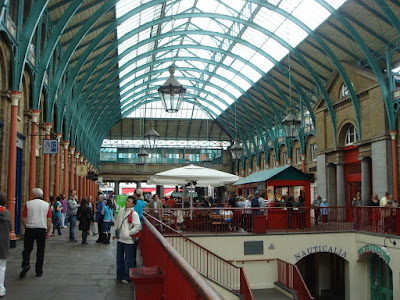

Eventually I made my way to two of the most popular shopping streets in all of London. The picture above is on Regent street. This street is filled with fancy shops and upscale department stores. It also had the biggest Apple store I've ever seen. I forgot to take a picture of it unfortunately, but it was two stories with about 80% of the store empty with only small tables along the perimeter. Fairly typical of any other Apple store, lots of wasted space.
The picture below was taken on Oxford street. It's a road practically 1 mile long filled with stores and department stores on either side. Unlike Regent street, the stores along this area were much more affordable.

I honestly spent almost the entire day just shopping around and I don't have very many pictures chronicling my shopping spree.
Fast forward a couple hours, I went back to the south eastern part of London and made a stop at the Globe Theater.
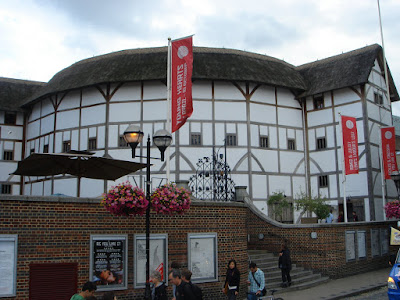
Shakespeare's original Globe Theater was destroyed in 1642. In 1997, a replica was built 750 ft. away from the original theater. Every summer plays are held in the building. I wanted to go inside or at least get close to check it out, but the entire theater was surrounded by gates. There was a line outside the entrance, but I don't know if it was a line for a play or a line for a tour. Instead of waiting to find out, I continued walking around until I found St. Paul's Cathedral.

This is where Prince Charles married Lady Diana in 1981. Anyway, that concluded my day. After a lot of shopping and walking around, I was exhausted and looking forward to just calling it a night.
This outside area is devoted to street performers. Early in the morning it wasn't very crowded at all. The weather wasn't very cooperative either, so that may have influenced the absence of entertainers. Inside the building on the left are stalls where local businesses sell their goods, ranging from glassware, ceramics, jewelry, hats, clothes, and random knickknacks. It's essentially a glorified farmer's market, some things were rather expensive (as in >100 euros).
Eventually I made my way to two of the most popular shopping streets in all of London. The picture above is on Regent street. This street is filled with fancy shops and upscale department stores. It also had the biggest Apple store I've ever seen. I forgot to take a picture of it unfortunately, but it was two stories with about 80% of the store empty with only small tables along the perimeter. Fairly typical of any other Apple store, lots of wasted space.
The picture below was taken on Oxford street. It's a road practically 1 mile long filled with stores and department stores on either side. Unlike Regent street, the stores along this area were much more affordable.
I honestly spent almost the entire day just shopping around and I don't have very many pictures chronicling my shopping spree.
Fast forward a couple hours, I went back to the south eastern part of London and made a stop at the Globe Theater.
Shakespeare's original Globe Theater was destroyed in 1642. In 1997, a replica was built 750 ft. away from the original theater. Every summer plays are held in the building. I wanted to go inside or at least get close to check it out, but the entire theater was surrounded by gates. There was a line outside the entrance, but I don't know if it was a line for a play or a line for a tour. Instead of waiting to find out, I continued walking around until I found St. Paul's Cathedral.
This is where Prince Charles married Lady Diana in 1981. Anyway, that concluded my day. After a lot of shopping and walking around, I was exhausted and looking forward to just calling it a night.
Subscribe to:
Posts (Atom)